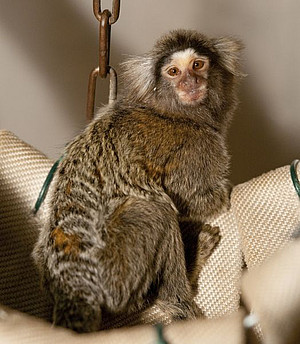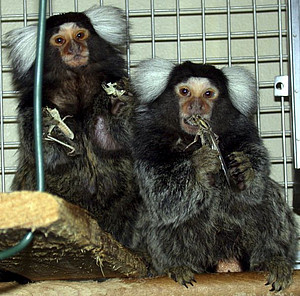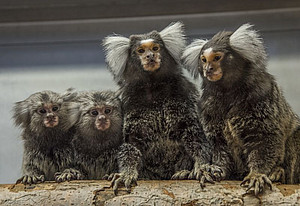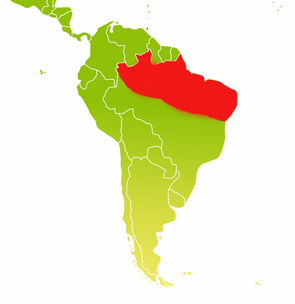Common marmoset
Common marmosets belong to the New World monkeys and are found in the northeastern Brazil. They are between 16 and 20 centimeters tall and weigh no more than 300 to 350 grams. Common marmosets are therefore also the smallest representative of the higher primates.
Special features
In addition to their small body size, the little monkeys are particularly known for their long gray-black ringed tail and the white tufts on their ears. The face is brightly colored, sparsely haired and a white spot is located on the forehead. Like all monkeys in the family to which the common marmosets belong, they have claw like nails on their fingers and toes. Only the big toe has the typical primate flat nail. With their claws, they can literally “hook” onto the bark of the trees and unlike other primates, they are capable of climbing up and down trees in a vertical position.
Diet
The main items on the menu of the common marmosets are plant exsudates and tree gums. During the dry season, these substances account for 80 per cent of their total diet. The availability of tree gums determines the group size and the survival chances of the common marmoset. Their particular dietary habits allow them to survive in smaller living areas and in so doing, they reduce competition with other primate species. The common marmosets use their special set of teeth to reach the sap of trees. They have enlarged, chisel-like incisors with reinforced enamel on the outside. The uneven wear and tear of tooth enamel and dentine lead to a constant sharpening of the "cutting edges". The common marmoset use the sharpened teeth to gnaw the bark and in so doing, stimulate the flow of plant juices and exsudates. During the rainy season 60 to 100 per cent of their diet consist of fruit. In addition, they eat flowers, nectar and fungi. Their animal food sources are grasshoppers, locusts, snails, small lizards and tree frogs.
Habitat and lifestyle
Marmosets can be found in a number of different types of forests. Since they are very adaptable, they can be found in the rainforest and coastal forests of Brazil as well as in the dry thorn savanna (Caatinga). They can also be encountered in suburban gardens, agricultural plantations and even in the public parks of Rio de Janeiro. The marmosets spend most of their day foraging. At night they sleep in lianas and in forked branches of treetops. The size of their home range is largely determined by the amount of the exudate-producing trees and is usually only two to six hectares. For their daily foraging, the marmosets cover between 500 meters and one kilometer.
Social behavior and reproduction
Marmosets usually live in groups of three to 15 individuals, where the group mostly consists of up to four adult males and females and their offspring. If the group becomes too big, migration that includes both sexes takes place. However, females leave the group more frequently than males. One breeding pair that is usually responsible for reproduction dominates the group. All the other members of the group are organized in an age dependent hierarchy after the breeding pair. The mating system of marmosets is very complex and variable. Previous studies with common marmosets have indicated an exclusively monogamous reproductive system. In the wild, additional mating systems such as polyandrous (one dominant female mates with multiple males) and polygynous (a dominant male mates with several females) were observed.
Births occur throughout the year but are more frequent from October to December (dry season) and from April to July (rainy season). The gestation period is approximately 145 days. Usually, common marmosets give birth to twins. Taking care of the infants (carrying and feeding) spells a higher energy input for the female. Thus, the rearing of the young is not solely left to the mother. All the other group members, especially adult males, help intensively in raising the young (cooperative rearing). After approximately ten weeks, the infants are weaned but they do take solid food to them from the age of four weeks. After three to four months the young animals are largely independent and they are fully grown after approximately 15 months.
Source: Handbook of the Mammals of the World: Primates (edited by Mittermeier, R.A., Ryland, A.B., Wilson D.E., published by Lynx Edicions, Conservation International, IUCN, 2013)
Profile of the common marmoset
| Scientific name | Callithrix jacchus |
|---|---|
| Taxonomy | Suborder: New World monkeys Family: Callitrichidae Genus: Marmosets Species: Common marmoset |
| Distribution | Northeast Brazil |
| Head and body length | 16 - 21 cm (males) 17 - 20 cm |
| Tail length | 25 - 31 cm (males) 24 - 30 cm |
| Weight | 317,9 g 322 g |
| Diet | exsudates (gums) and plant saps of trees and vines, fruits, flowers, nectar, fungi, bark, insects, spiders, snails, small lizards, bird eggs, tree frogs, small rodents |
| Lifestyle | diurnal, arboreal |
| Social organization | mixed-gender family units, usually with a dominant breeding pair |
| Mating system | monogamous, polyandrous, polygynous |
| Lifestyle (husbandry) | up tp 15 years |
| Status (IUCN Red List) | least concern |





